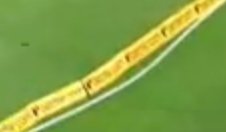
 |
| Back | ||||||
Obstacles on the field
The questions being pondered are, "What happens if the ball hits the plastic but does not go onto the boundary rope?", "What happens if the ball is hit and lands first bounce between the plastic wedge and the boundary rope? Is it a six?", and using the same scenario "If a fielder catches the ball in the gap between the plastic wedge and the rope, is the striker out?" The question of the way the boundary is marked is determined by the Laws of Cricket, and will be subject to match regulations, especially for Test matches. In the situation that has aroused interest, the relevant bit of Law is Laws 19.3 (Restoring the boundary). . If the boundary marker is disturbed during play it should be restored to its original position as soon as the ball is dead. To speculate what might happen if that is not done is to try to argue a case based on a dodgy premise. Once the Laws have been ignored, it is difficult, often impossible, to try to use those same Laws to resolve a problem. However, there are a number of things that can be said. It is possible to argue that, if the rope is the boundary, the 'wedges' become obstacles. If they detach from the rope and are within the field of play, they remain obstacles and are covered by Law 19.2.6 which says that the umpires will award a boundary if the ball comes into contact with the obstacle, provided that has been decided by the umpires before the toss (or is in the regulations). It does not say that the obstacle becomes the boundary, simply that it shall be regarded as a boundary. The logic is similar if the 'wedges' are the boundary and the rope is the obstacle. It is not unlike having a tree within the field of play. It is normally surrounded in some way by a boundary mark and is itself beyond the boundary, yet the area of the field of play between the tree's boundary and the rope (or whatever marks the ultimate boundary) is still part of the field of play. In the end, though, the fact remains that the situation under discussion is brought about by an umpiring error and the argument cannot easily be progressed beyond guesswork. Read more about Law 19 (Boundaries) at the MCC website | ||||||